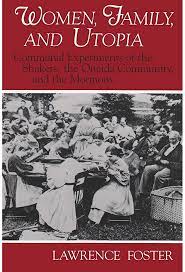Articles/Essays – Volume 25, No. 4
Mormon Women and Families | Lawrence Foster, Women, Family, and Utopia: Communal Experiments of the Shakers, the Oneida Community, and the Mormons
In Women, Family, and Utopia, Lawrence Foster, an associate professor of Ameri can history at the Georgia Institute of Technology in Atlanta, establishes two goals: to expand on his research regarding “relations between men and women in the early Shaker, Oneida Perfectionist, and Mormon movements for those who may never have heard of their experiments” and to further explore the way these groups dealt with the issues of “the changing role of women, the nature of the family, and the impact of sexuality . . . on society” (p. xiv). To accomplish this, Foster divides this book along the same lines as his 1984 Religion and Sexuality; he begins with the Shakers, proceeds to the Oneida Community, and ends with the Church of Jesus Christ of Latter-day Saints.
Unlike the earlier book, however, these sections, and especially their individual chapters, read more like discrete essays than a monograph unified by an overarching theme. Foster maintains that his chief intent is to view these three groups “as part of a total gestalt, system, or way of life” that will offer insight into our own era. But because he has chosen to avoid any application of a “theoretical analysis” or of modern feminist thought to his approach and has instead “let these groups speak for themselves about their attitudes toward the role of women in society,” the messages to be drawn from their experiments are not readily apparent (p. xv).
On closer examination, it is clear that Foster has drawn heavily on his Religion and Sexuality in ways other than just organizational structure. Although he claims that the previously published portions of this current book have been “substantially revised” (p. xiv), in reality many para graphs, and even pages, are close para phrases of material from his earlier volume. For example, comparison with his previous book of sections concerning the difficulties faced by missionaries’ wives (p. 131), historians’ “head-counts” of Joseph Smith’s wives (p. 136), the refusal of Smith’s wives to identify the father of their children (p. 141), the account of James J. Strang’s birth and childhood (p. 172), a description of Jane Snyder Richards (p. 183), and an analysis of the Woman’s Exponent (p. 194) show few changes from the original wording. Indeed, a substantial amount of material regarding Mor mons seems to have been taken from Religion and Sexuality and rearranged without significant revision.
Among the new information Foster does add is his hypothesis that Joseph Smith spent a great deal of time and energy establishing polygamy in the years before his death because he may have suffered from “manic-depressive disease,” as did his son David Hyrum and at least six other of Smith’s male descendants (p. 162). First alerted to this possibility by a Mormon psychiatrist, Foster examines Smith’s expansiveness, grandiosity, and hyper-sexuality between 1841 and 1844, arguing that these characteristics could well have been symptoms of manic depressive disorder (p. 165).
Foster also adds new material regarding women. In an essay titled “From Activism to Domesticity: The Changing Role of Mormon Women in the Nineteenth and Twentieth Centuries,” he vividly demonstrates the switch from early Mormon women’s “real power, influence, and independence” to the current “gush and cloying sentimentality” emphasizing domesticity “as the only important role for women” (pp. 202, 209). In a fascinating analysis of the Sonia Johnson case, Foster compares it to heretic Anne Hutchinson’s trial of 1637, also a “travesty of justice.” He concludes that the Church “seriously miscalculated” its handling of the case which in turn led to tensions and “something of a siege mentality” within the Church (p. 215).
Foster’s comments concerning Mormon women, however, would have been more meaningful had he not viewed them as a largely homogeneous group. Throughout the early essays concerning the Church, for example, Foster focuses primarily on polygamy. Although he notes that “at most only 15 to 20 percent were polygamous,” he ignores women in nonpolygamous situations. In the later essays, he generalizes his observations to all Mormon women, regardless of social class, race, ethnicity, or age. Certainly, discriminating among Mormon women’s experiences according to such characteristics as monogamy, rural or urban, and educational level would add depth and complexity to our understanding of those women.
In addition, it is important to remember that children are an integral part of families. Foster has little to say about babies and children, either in the nineteenth century or the twentieth. Yet, children who lived in communal families dif fered in numerous crucial ways from other children. And surely such a practice as denying a child’s paternity to protect a polygamous father, or telling a child in later life that his or her father was some one else, had a profound effect on family dynamics.
These comments are not meant to suggest that Foster’s book is ineffective. On the contrary, Foster has provided an overview of the Shakers, the Oneida Community, and the Mormons; has raised a multitude of intriguing questions; and has opened the way for further significant discussion. He set himself a nigh impossible task here; discussing women, family, and the Church of Jesus Christ of Latter-day Saints could fill a thick volume in itself. Perhaps he will continue his work by elab orating on the complexity of Mormon women and their families.
Women, Family, and Utopia: Communal Experiments of the Shakers, the Oneida Community, and the Mormons by Lawrence Foster (Syracuse: Syracuse University Press, 1991), 343 pp. inc. notes.


 Back to full Issue
Back to full Issue

